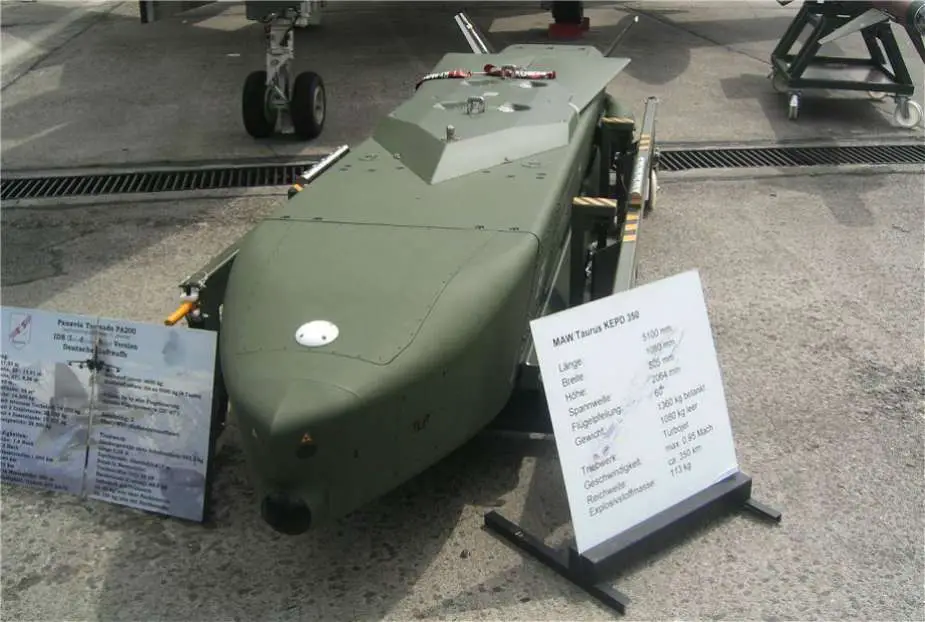Breaking news
Which Tactical Capabilities Do German Taurus Missiles Offer Ukraine in Its Fight Against Russia?.
As the Ukrainian armed forces continue to seek ways to bolster their capabilities in the ongoing conflict, their focus has turned towards acquiring the Taurus long-range, precision-guided cruise missiles from Germany. This strategic move has gained significant attention following former German President Joachim Gauck's call for Germany to supply these missiles to Ukraine, as reported in an interview with Bild am Sonntag on January 7, 2023.
Follow Army Recognition on Google News at this link

The Taurus KEPD 350's combination of long-range, stealth, precision, and versatile warhead capabilities offers a significant operational advantage to the Ukrainian armed forces. (Picture source Wikimedia)
The Taurus missiles, renowned for their stealth and accuracy, are seen as a valuable addition to Ukraine's military arsenal. Capable of flying at low altitudes and evading radar detection, these missiles are particularly suited to the challenging warfare landscape in Ukraine, offering the potential for surprise strikes against well-defended targets.
The discussion around the Taurus missiles has been intensifying since Ukraine first submitted its request for these weapons in May 2023. With a range of up to 500 kilometers, these missiles would enable the Ukrainian forces to conduct long-range precision strikes deep into enemy territory, disrupting key installations and command centers.
However, the decision to supply Ukraine with Taurus missiles is not without controversy. Bild reported in October that German Chancellor Olaf Scholz opposed sending Taurus missiles to Kyiv, citing concerns about Germany being drawn directly into the war. This hesitation comes despite Ukraine having already received other long-range missiles like the Storm Shadow from the U.K. and the SCALP from France.
The integration of Taurus missiles into Ukraine's military strategy could be a game-changer in the conflict. These missiles would not only strengthen Ukraine's defensive capabilities but also provide a significant offensive advantage. The ability to conduct precision strikes over long distances could alter the dynamics on the battlefield, offering Ukraine a chance to shift the balance of power in its favor.
In summary, the acquisition of Taurus missiles stands as a critical decision point, not just for Ukraine, but also for Germany and the broader international community involved in the conflict. The outcome of this decision could have far-reaching implications on the course of the war and the future of Ukraine's sovereignty.
The Taurus KEPD 350 missile presents a significant operational advantage for the Ukrainian armed forces, particularly in the context of their ongoing conflict. Its operational range, exceeding 500 kilometers, is a key feature that allows Ukrainian forces to engage targets from a safe distance, well beyond the reach of most enemy air defenses. This capability is crucial in modern warfare where minimizing risks to aircraft and crew is a top priority.
One of the standout features of the Taurus missile is its stealth capability, enabled by its very low level terrain-following flight. This ability to fly close to the ground helps it evade radar detection, making it an ideal weapon for penetrating dense air defenses. For Ukraine, this means the ability to conduct surprise strikes on well-protected enemy installations and high-value targets without alerting adversary defense systems.
The missile's navigation system is another aspect that sets it apart. It utilizes an inertial navigation system (INS) continuously supported by GPS, alongside image-based and terrain reference sensors. This multi-faceted approach ensures highly accurate targeting, even in environments where GPS signals are compromised or jammed. In a conflict like Ukraine's, where electronic warfare and signal jamming are prevalent, such a GPS-independent system is invaluable.
Moreover, the Taurus missile's dual-stage warhead system, which combines penetration capabilities for hard and deeply buried targets (HDBT) with blast fragmentation effects for area targets, makes it highly versatile. This is particularly relevant for striking a range of strategic targets, from fortified bunkers to larger area targets. The missile's unique 'layer counting' fuze technology allows for detonation at pre-selected levels within a target structure, enhancing its effectiveness against multi-layered defense systems.
Additionally, the Taurus missile's adaptability to various aircraft types, including the possibility of deployment from ground and sea platforms, offers strategic flexibility. For the Ukrainian forces, this means the potential to integrate the missile into different platforms based on tactical needs.
The Taurus KEPD 350's combination of long-range, stealth, precision, and versatile warhead capabilities offers a significant operational advantage to the Ukrainian armed forces. Its ability to conduct precise, long-range strikes with a high degree of survivability and effectiveness makes it a potent addition to Ukraine's military capabilities in the face of a challenging conflict environment.
Defense News January 2024























